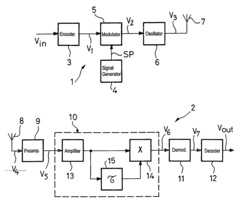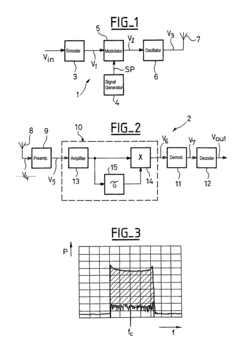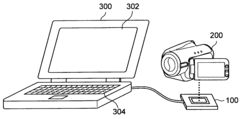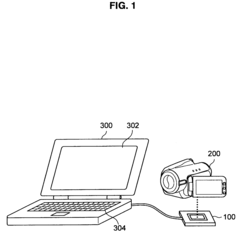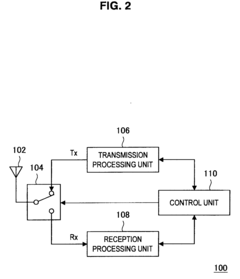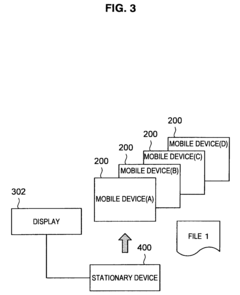How to Facilitate Global Communication Through Electromagnetic Waves?
JUL 11, 20259 MIN READ
Generate Your Research Report Instantly with AI Agent
Patsnap Eureka helps you evaluate technical feasibility & market potential.
EM Wave Communication Evolution and Objectives
Electromagnetic wave communication has revolutionized global connectivity since its inception in the late 19th century. The evolution of this technology has been marked by significant milestones, from Marconi's first transatlantic radio transmission to the development of modern cellular networks and satellite communications. This journey reflects humanity's persistent quest for faster, more reliable, and more widespread communication methods.
The primary objective in facilitating global communication through electromagnetic waves is to overcome geographical barriers and enable seamless information exchange across vast distances. This goal encompasses improving signal quality, increasing data transmission rates, expanding network coverage, and enhancing the overall efficiency of communication systems. As technology advances, the focus has shifted towards developing more sophisticated modulation techniques, optimizing spectrum utilization, and exploring higher frequency bands to accommodate the growing demand for data-intensive applications.
In recent years, the emergence of 5G technology has marked a significant leap forward in electromagnetic wave communication. This next-generation network promises ultra-low latency, massive device connectivity, and unprecedented data speeds. The objectives for 5G and beyond include supporting the Internet of Things (IoT), enabling autonomous vehicles, and facilitating augmented and virtual reality applications on a global scale.
Looking ahead, the field of electromagnetic wave communication is poised for further innovation. Researchers are exploring terahertz frequencies, which offer the potential for even higher data rates and more precise spatial resolution. Additionally, there is growing interest in developing quantum communication systems that leverage the principles of quantum mechanics to achieve theoretically unhackable data transmission.
Another critical objective is to address the environmental and energy efficiency aspects of global communication systems. As the number of connected devices continues to grow exponentially, there is an increasing need to develop more energy-efficient transmission technologies and sustainable infrastructure. This includes optimizing power consumption in base stations, improving the energy efficiency of end-user devices, and exploring alternative energy sources for remote communication nodes.
The ongoing evolution of electromagnetic wave communication also aims to bridge the digital divide by extending connectivity to underserved and remote areas. This involves developing innovative solutions such as high-altitude platform stations (HAPS) and low Earth orbit (LEO) satellite constellations to provide internet access to regions where traditional infrastructure is impractical or economically unfeasible.
The primary objective in facilitating global communication through electromagnetic waves is to overcome geographical barriers and enable seamless information exchange across vast distances. This goal encompasses improving signal quality, increasing data transmission rates, expanding network coverage, and enhancing the overall efficiency of communication systems. As technology advances, the focus has shifted towards developing more sophisticated modulation techniques, optimizing spectrum utilization, and exploring higher frequency bands to accommodate the growing demand for data-intensive applications.
In recent years, the emergence of 5G technology has marked a significant leap forward in electromagnetic wave communication. This next-generation network promises ultra-low latency, massive device connectivity, and unprecedented data speeds. The objectives for 5G and beyond include supporting the Internet of Things (IoT), enabling autonomous vehicles, and facilitating augmented and virtual reality applications on a global scale.
Looking ahead, the field of electromagnetic wave communication is poised for further innovation. Researchers are exploring terahertz frequencies, which offer the potential for even higher data rates and more precise spatial resolution. Additionally, there is growing interest in developing quantum communication systems that leverage the principles of quantum mechanics to achieve theoretically unhackable data transmission.
Another critical objective is to address the environmental and energy efficiency aspects of global communication systems. As the number of connected devices continues to grow exponentially, there is an increasing need to develop more energy-efficient transmission technologies and sustainable infrastructure. This includes optimizing power consumption in base stations, improving the energy efficiency of end-user devices, and exploring alternative energy sources for remote communication nodes.
The ongoing evolution of electromagnetic wave communication also aims to bridge the digital divide by extending connectivity to underserved and remote areas. This involves developing innovative solutions such as high-altitude platform stations (HAPS) and low Earth orbit (LEO) satellite constellations to provide internet access to regions where traditional infrastructure is impractical or economically unfeasible.
Global Demand for EM Wave Communication
The global demand for electromagnetic wave communication has been steadily increasing over the past few decades, driven by the rapid advancement of technology and the growing need for seamless connectivity across borders. This demand is particularly evident in various sectors, including telecommunications, broadcasting, satellite communications, and emerging technologies such as the Internet of Things (IoT) and 5G networks.
In the telecommunications industry, the demand for high-speed, reliable, and widespread connectivity has led to significant investments in infrastructure and technology. Mobile networks have evolved from 2G to 5G, with each generation offering faster data speeds and lower latency. This progression has been fueled by the increasing consumer appetite for mobile data, video streaming, and real-time applications.
The broadcasting sector has also witnessed a shift towards digital transmission, utilizing electromagnetic waves to deliver high-quality audio and video content to audiences worldwide. Satellite television and radio continue to play a crucial role in providing access to information and entertainment, especially in remote areas where terrestrial infrastructure is limited.
Satellite communications have become indispensable for global connectivity, supporting various applications such as navigation systems, weather forecasting, and emergency communications. The growing number of satellite constellations, including those for low Earth orbit (LEO) networks, demonstrates the increasing demand for global coverage and low-latency communication.
The emergence of IoT has further amplified the need for electromagnetic wave communication. As billions of devices become interconnected, there is a growing requirement for efficient and reliable wireless communication protocols to support data exchange between these devices. This trend is expected to continue as smart cities, industrial automation, and connected vehicles become more prevalent.
The development of 5G networks represents a significant leap in electromagnetic wave communication capabilities. The technology promises ultra-fast speeds, massive device connectivity, and ultra-low latency, opening up new possibilities for applications such as augmented reality, virtual reality, and autonomous vehicles. The global race to deploy 5G infrastructure underscores the critical importance of advanced electromagnetic wave communication in driving economic growth and technological innovation.
In the maritime and aviation sectors, electromagnetic wave communication plays a vital role in ensuring safety and efficiency. Satellite-based systems provide crucial connectivity for ships and aircraft, enabling real-time tracking, weather updates, and communication with ground control.
As the world becomes increasingly interconnected, there is a growing demand for cross-border communication solutions that can overcome language barriers and cultural differences. This has led to increased interest in developing advanced translation technologies and universal communication platforms that leverage electromagnetic waves to facilitate global understanding and collaboration.
In the telecommunications industry, the demand for high-speed, reliable, and widespread connectivity has led to significant investments in infrastructure and technology. Mobile networks have evolved from 2G to 5G, with each generation offering faster data speeds and lower latency. This progression has been fueled by the increasing consumer appetite for mobile data, video streaming, and real-time applications.
The broadcasting sector has also witnessed a shift towards digital transmission, utilizing electromagnetic waves to deliver high-quality audio and video content to audiences worldwide. Satellite television and radio continue to play a crucial role in providing access to information and entertainment, especially in remote areas where terrestrial infrastructure is limited.
Satellite communications have become indispensable for global connectivity, supporting various applications such as navigation systems, weather forecasting, and emergency communications. The growing number of satellite constellations, including those for low Earth orbit (LEO) networks, demonstrates the increasing demand for global coverage and low-latency communication.
The emergence of IoT has further amplified the need for electromagnetic wave communication. As billions of devices become interconnected, there is a growing requirement for efficient and reliable wireless communication protocols to support data exchange between these devices. This trend is expected to continue as smart cities, industrial automation, and connected vehicles become more prevalent.
The development of 5G networks represents a significant leap in electromagnetic wave communication capabilities. The technology promises ultra-fast speeds, massive device connectivity, and ultra-low latency, opening up new possibilities for applications such as augmented reality, virtual reality, and autonomous vehicles. The global race to deploy 5G infrastructure underscores the critical importance of advanced electromagnetic wave communication in driving economic growth and technological innovation.
In the maritime and aviation sectors, electromagnetic wave communication plays a vital role in ensuring safety and efficiency. Satellite-based systems provide crucial connectivity for ships and aircraft, enabling real-time tracking, weather updates, and communication with ground control.
As the world becomes increasingly interconnected, there is a growing demand for cross-border communication solutions that can overcome language barriers and cultural differences. This has led to increased interest in developing advanced translation technologies and universal communication platforms that leverage electromagnetic waves to facilitate global understanding and collaboration.
Current EM Wave Tech Challenges
The current challenges in electromagnetic (EM) wave technology for global communication are multifaceted and complex. One of the primary obstacles is the limited spectrum availability, particularly in the lower frequency bands. As the demand for wireless communication continues to grow exponentially, the congestion in these bands has become increasingly problematic, leading to interference and reduced performance.
Another significant challenge is the need for improved energy efficiency in EM wave-based communication systems. The power consumption of transmitters and receivers remains a critical concern, especially for mobile devices and remote installations. Developing more energy-efficient technologies is crucial for extending battery life and reducing the environmental impact of global communication networks.
Signal propagation issues present ongoing difficulties, particularly in urban environments and over long distances. Multipath fading, signal attenuation, and atmospheric effects can significantly degrade communication quality and reliability. Overcoming these propagation challenges is essential for maintaining robust global connectivity.
The increasing demand for higher data rates and lower latency poses another substantial challenge. As applications such as virtual reality, autonomous vehicles, and the Internet of Things (IoT) become more prevalent, the need for faster and more responsive communication systems intensifies. This requires advancements in modulation techniques, signal processing, and network architecture.
Security and privacy concerns also present significant challenges in EM wave-based global communication. As more sensitive information is transmitted wirelessly, protecting against eavesdropping, jamming, and other forms of interference becomes increasingly critical. Developing robust encryption and authentication methods that can be efficiently implemented in EM wave systems is an ongoing area of research.
The integration of EM wave technology with emerging technologies such as artificial intelligence and edge computing presents both opportunities and challenges. Leveraging these technologies to optimize spectrum usage, improve network management, and enhance overall system performance is a complex task that requires interdisciplinary expertise.
Lastly, the global nature of EM wave-based communication systems necessitates addressing regulatory and standardization challenges. Harmonizing frequency allocations, emission standards, and interoperability requirements across different countries and regions is crucial for facilitating seamless global communication. Overcoming these regulatory hurdles requires ongoing international cooperation and coordination.
Another significant challenge is the need for improved energy efficiency in EM wave-based communication systems. The power consumption of transmitters and receivers remains a critical concern, especially for mobile devices and remote installations. Developing more energy-efficient technologies is crucial for extending battery life and reducing the environmental impact of global communication networks.
Signal propagation issues present ongoing difficulties, particularly in urban environments and over long distances. Multipath fading, signal attenuation, and atmospheric effects can significantly degrade communication quality and reliability. Overcoming these propagation challenges is essential for maintaining robust global connectivity.
The increasing demand for higher data rates and lower latency poses another substantial challenge. As applications such as virtual reality, autonomous vehicles, and the Internet of Things (IoT) become more prevalent, the need for faster and more responsive communication systems intensifies. This requires advancements in modulation techniques, signal processing, and network architecture.
Security and privacy concerns also present significant challenges in EM wave-based global communication. As more sensitive information is transmitted wirelessly, protecting against eavesdropping, jamming, and other forms of interference becomes increasingly critical. Developing robust encryption and authentication methods that can be efficiently implemented in EM wave systems is an ongoing area of research.
The integration of EM wave technology with emerging technologies such as artificial intelligence and edge computing presents both opportunities and challenges. Leveraging these technologies to optimize spectrum usage, improve network management, and enhance overall system performance is a complex task that requires interdisciplinary expertise.
Lastly, the global nature of EM wave-based communication systems necessitates addressing regulatory and standardization challenges. Harmonizing frequency allocations, emission standards, and interoperability requirements across different countries and regions is crucial for facilitating seamless global communication. Overcoming these regulatory hurdles requires ongoing international cooperation and coordination.
Existing EM Wave Solutions
01 Antenna design for electromagnetic wave communication
Various antenna designs are utilized to improve electromagnetic wave communication. These designs focus on enhancing signal strength, directionality, and efficiency. Innovations in antenna technology include multi-band antennas, adaptive arrays, and compact designs for mobile devices.- Antenna design for electromagnetic wave communication: Various antenna designs are utilized to improve electromagnetic wave communication. These include specialized configurations to enhance signal transmission and reception, optimize bandwidth, and reduce interference. Advanced antenna designs can significantly improve the efficiency and reliability of wireless communication systems.
- Electromagnetic shielding techniques: Electromagnetic shielding is crucial in preventing interference and improving signal quality in communication systems. This involves the use of conductive or magnetic materials to block or absorb electromagnetic waves. Effective shielding can enhance the performance of wireless devices and reduce electromagnetic pollution.
- Modulation and signal processing methods: Advanced modulation techniques and signal processing methods are employed to enhance the efficiency of electromagnetic wave communication. These include various digital modulation schemes, error correction algorithms, and adaptive signal processing techniques to improve data transmission rates and reliability in challenging environments.
- Electromagnetic wave propagation in specific mediums: Research focuses on understanding and optimizing electromagnetic wave propagation in various mediums, such as air, water, or specific materials. This knowledge is applied to develop more effective communication systems for different environments, including underwater communication or through-wall transmission.
- Integration of electromagnetic wave communication in IoT devices: The integration of electromagnetic wave communication technologies in Internet of Things (IoT) devices is a growing field. This involves developing low-power, compact communication modules that can be easily incorporated into various IoT applications, enabling seamless connectivity and data exchange in smart environments.
02 Electromagnetic wave shielding techniques
Shielding techniques are employed to protect electronic devices from electromagnetic interference and improve communication quality. These methods involve using specialized materials and structures to absorb or reflect unwanted electromagnetic waves, ensuring better signal integrity and reducing noise in communication systems.Expand Specific Solutions03 Wireless communication protocols and standards
Development of various wireless communication protocols and standards to facilitate efficient electromagnetic wave communication. These include advancements in cellular technologies, Wi-Fi, Bluetooth, and other short-range communication methods, focusing on improving data rates, reducing latency, and enhancing overall performance.Expand Specific Solutions04 Signal processing techniques for electromagnetic wave communication
Advanced signal processing techniques are implemented to enhance the quality and reliability of electromagnetic wave communication. These include methods for noise reduction, signal amplification, modulation schemes, and error correction algorithms, all aimed at improving the overall performance of communication systems.Expand Specific Solutions05 Energy-efficient electromagnetic wave communication systems
Development of energy-efficient communication systems that optimize power consumption while maintaining high performance. These innovations focus on reducing the energy required for transmitting and receiving electromagnetic waves, improving battery life in mobile devices, and minimizing the environmental impact of communication infrastructure.Expand Specific Solutions
Key Players in EM Wave Industry
The global communication through electromagnetic waves market is in a mature stage, with established players and ongoing technological advancements. The market size is substantial, driven by increasing demand for wireless communication technologies across various sectors. Companies like Huawei, Intel, and Sony are at the forefront of innovation, developing cutting-edge solutions in 5G, IoT, and satellite communications. Academic institutions such as Zhejiang University and the University of Tokyo contribute significantly to research and development. The technology's maturity is evident in widespread applications, yet there's continuous evolution towards more efficient and faster communication systems, with companies like Motorola Mobility and NEC pushing boundaries in network infrastructure and device capabilities.
Intel Corp.
Technical Solution: Intel's contribution to global communication through electromagnetic waves centers on developing advanced chipsets and modems for 5G and future wireless technologies. Their 5G modem solutions support both sub-6 GHz and mmWave frequencies, enabling high-speed, low-latency communication across various network deployments[13]. Intel has also invested in developing Field Programmable Gate Arrays (FPGAs) for flexible, software-defined radio implementations, allowing for adaptable network infrastructure[14]. Additionally, they are researching AI-powered network optimization techniques to enhance spectrum efficiency and reduce power consumption in wireless communication systems[15].
Strengths: Cutting-edge semiconductor technology, strong presence in both consumer and enterprise markets. Weaknesses: Facing increased competition in the mobile chipset market.
Huawei Technologies Co., Ltd.
Technical Solution: Huawei has developed advanced 5G technology to facilitate global communication through electromagnetic waves. Their 5G base stations utilize massive MIMO (Multiple-Input Multiple-Output) technology, which significantly improves spectrum efficiency and network capacity[1]. Huawei's 5G solutions incorporate beamforming techniques, allowing for precise directional signal transmission, reducing interference, and enhancing coverage[2]. They have also implemented network slicing, enabling customized virtual networks for different applications and services, ensuring optimal performance for diverse communication needs[3].
Strengths: Industry-leading 5G technology, high spectrum efficiency, and extensive global deployment. Weaknesses: Geopolitical challenges affecting market access in some countries.
Core EM Wave Innovations
Method of communicating information between a transmitter and a receiver using ultrawideband signals
PatentActiveUS7236509B2
Innovation
- A method using a subcarrier modulator, high frequency oscillator, and off-the-shelf components to transmit and receive UWB signals, eliminating the need for synchronization through double demodulation and employing a delay line with a surface or bulk acoustic wave line for demodulation, allowing for simple circuit construction.
Communication Apparatus, Communication System, Communication Method, and Program
PatentInactiveUS20090290027A1
Innovation
- A communication apparatus and system that enables data file transfer to multiple devices using a plural transfer mode, which allows for simultaneous selection and transfer of data files across established connections, with features like transfer number input, time-out detection, and ID matching for error prevention, simplifying the process by maintaining the selected data file state and canceling the mode as needed.
Spectrum Allocation Policies
Spectrum allocation policies play a crucial role in facilitating global communication through electromagnetic waves. These policies govern the distribution and management of radio frequency spectrum, a finite resource essential for wireless communications. The International Telecommunication Union (ITU) oversees global spectrum allocation, while national regulatory bodies implement and enforce these policies within their jurisdictions.
Historically, spectrum allocation followed a command-and-control approach, with governments assigning specific frequency bands to particular services or users. However, this method has proven inefficient in meeting the growing demand for wireless services. In response, many countries have adopted market-based approaches, such as spectrum auctions and trading, to promote more efficient use of the spectrum.
The advent of 5G technology has further emphasized the importance of effective spectrum allocation policies. 5G networks require a mix of low, mid, and high-frequency bands to deliver their full potential. This has led to a reevaluation of existing spectrum allocations and the exploration of new frequency bands, such as millimeter-wave spectrum.
Harmonization of spectrum allocation across regions is another critical aspect of facilitating global communication. Aligned frequency bands enable economies of scale in device manufacturing and simplify international roaming. However, achieving global harmonization remains challenging due to varying national priorities and legacy spectrum uses.
Dynamic spectrum access technologies, such as cognitive radio and TV white spaces, are emerging as potential solutions to spectrum scarcity. These technologies allow for more flexible and efficient use of the spectrum by enabling devices to access unused frequency bands opportunistically. Regulatory frameworks are evolving to accommodate these innovations while ensuring protection for incumbent users.
The increasing demand for satellite-based communications, including low Earth orbit (LEO) constellations, has added another layer of complexity to spectrum allocation policies. Balancing the needs of terrestrial and satellite services while avoiding harmful interference requires careful coordination at both national and international levels.
As the Internet of Things (IoT) continues to expand, spectrum allocation policies must also address the unique requirements of massive machine-type communications. This includes allocating suitable frequency bands for low-power, wide-area networks and developing regulatory frameworks that support the deployment of billions of connected devices.
Historically, spectrum allocation followed a command-and-control approach, with governments assigning specific frequency bands to particular services or users. However, this method has proven inefficient in meeting the growing demand for wireless services. In response, many countries have adopted market-based approaches, such as spectrum auctions and trading, to promote more efficient use of the spectrum.
The advent of 5G technology has further emphasized the importance of effective spectrum allocation policies. 5G networks require a mix of low, mid, and high-frequency bands to deliver their full potential. This has led to a reevaluation of existing spectrum allocations and the exploration of new frequency bands, such as millimeter-wave spectrum.
Harmonization of spectrum allocation across regions is another critical aspect of facilitating global communication. Aligned frequency bands enable economies of scale in device manufacturing and simplify international roaming. However, achieving global harmonization remains challenging due to varying national priorities and legacy spectrum uses.
Dynamic spectrum access technologies, such as cognitive radio and TV white spaces, are emerging as potential solutions to spectrum scarcity. These technologies allow for more flexible and efficient use of the spectrum by enabling devices to access unused frequency bands opportunistically. Regulatory frameworks are evolving to accommodate these innovations while ensuring protection for incumbent users.
The increasing demand for satellite-based communications, including low Earth orbit (LEO) constellations, has added another layer of complexity to spectrum allocation policies. Balancing the needs of terrestrial and satellite services while avoiding harmful interference requires careful coordination at both national and international levels.
As the Internet of Things (IoT) continues to expand, spectrum allocation policies must also address the unique requirements of massive machine-type communications. This includes allocating suitable frequency bands for low-power, wide-area networks and developing regulatory frameworks that support the deployment of billions of connected devices.
EM Wave Environmental Impact
The environmental impact of electromagnetic (EM) waves used for global communication is a critical consideration in the development and deployment of communication technologies. As these waves propagate through the atmosphere and interact with various elements of the environment, they can potentially affect ecosystems, human health, and atmospheric conditions.
One of the primary concerns is the potential impact on wildlife, particularly migratory birds and marine life. Studies have shown that certain frequencies of EM waves can interfere with the navigation systems of birds, potentially disrupting their migration patterns. Similarly, marine animals that rely on electromagnetic fields for orientation and navigation may be affected by the increased presence of artificial EM waves in their habitats.
The proliferation of communication infrastructure, such as cell towers and satellite systems, has led to an increase in electromagnetic radiation in both urban and rural environments. This has raised questions about the long-term effects on human health, with ongoing research investigating potential links to various health issues. While current scientific consensus suggests that exposure to low-level EM radiation is generally safe, continued monitoring and research are essential to ensure public safety.
Atmospheric interactions with EM waves used for communication can also have environmental implications. The ionosphere, a layer of the Earth's upper atmosphere, plays a crucial role in reflecting certain radio waves used for long-distance communication. Intensive use of these frequencies could potentially alter the ionosphere's properties, affecting natural phenomena such as the aurora borealis and potentially impacting climate patterns.
The energy consumption associated with generating and transmitting EM waves for global communication is another environmental concern. As the demand for faster and more widespread communication increases, so does the energy required to power the necessary infrastructure. This increased energy demand contributes to greenhouse gas emissions and places additional strain on power grids.
Efforts to mitigate the environmental impact of EM wave-based communication systems are ongoing. These include developing more energy-efficient transmission technologies, optimizing the placement of communication infrastructure to minimize wildlife disruption, and exploring alternative communication methods that have less environmental impact. Additionally, international regulations and standards are being developed to ensure that the expansion of global communication networks proceeds in an environmentally responsible manner.
One of the primary concerns is the potential impact on wildlife, particularly migratory birds and marine life. Studies have shown that certain frequencies of EM waves can interfere with the navigation systems of birds, potentially disrupting their migration patterns. Similarly, marine animals that rely on electromagnetic fields for orientation and navigation may be affected by the increased presence of artificial EM waves in their habitats.
The proliferation of communication infrastructure, such as cell towers and satellite systems, has led to an increase in electromagnetic radiation in both urban and rural environments. This has raised questions about the long-term effects on human health, with ongoing research investigating potential links to various health issues. While current scientific consensus suggests that exposure to low-level EM radiation is generally safe, continued monitoring and research are essential to ensure public safety.
Atmospheric interactions with EM waves used for communication can also have environmental implications. The ionosphere, a layer of the Earth's upper atmosphere, plays a crucial role in reflecting certain radio waves used for long-distance communication. Intensive use of these frequencies could potentially alter the ionosphere's properties, affecting natural phenomena such as the aurora borealis and potentially impacting climate patterns.
The energy consumption associated with generating and transmitting EM waves for global communication is another environmental concern. As the demand for faster and more widespread communication increases, so does the energy required to power the necessary infrastructure. This increased energy demand contributes to greenhouse gas emissions and places additional strain on power grids.
Efforts to mitigate the environmental impact of EM wave-based communication systems are ongoing. These include developing more energy-efficient transmission technologies, optimizing the placement of communication infrastructure to minimize wildlife disruption, and exploring alternative communication methods that have less environmental impact. Additionally, international regulations and standards are being developed to ensure that the expansion of global communication networks proceeds in an environmentally responsible manner.
Unlock deeper insights with Patsnap Eureka Quick Research — get a full tech report to explore trends and direct your research. Try now!
Generate Your Research Report Instantly with AI Agent
Supercharge your innovation with Patsnap Eureka AI Agent Platform!
